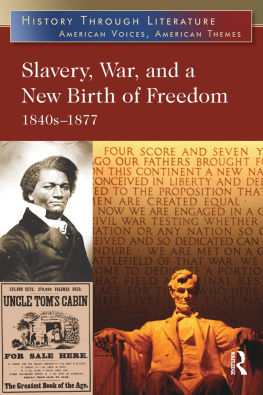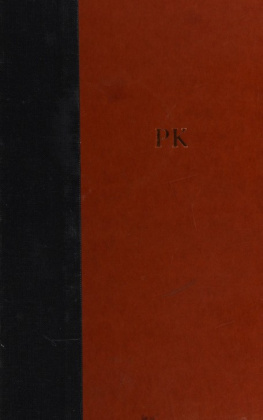Slavery, War, and a New Birth of Freedom
1840s1877
Editorial Advisers
Steven A. Goldberg
Past President, National Council for the Social Studies
Social Studies Department Chair
New Rochelle High School, New Rochelle, New York
Louise A. Hazebrouck
English teacher
Horace Greeley High School, Chappaqua, New York
Deborah Boxer Minchin
Social Studies teacher
New Rochelle High School, New Rochelle, New York
HISTORY THROUGH LITERATURE
AMERICAN VOICES, AMERICAN THEMES
Slavery, War, and a New Birth of Freedom
1840s1877
Jeffrey H. Hacker, Editor
First published 2014 by M.E. Sharpe
Published 2015 by Routledge
2 Park Square, Milton Park, Abingdon, Oxon OX14 4RN
711 Third Avenue, New York, NY, 10017, USA
Routledge is an imprint of the Taylor & Francis Group, an informa business
Copyright 2014, Taylor & Francis. All rights reserved.
Cover images (clockwise from top left) provided by : AP Photo; Reza Estakhrian/Getty Images; Kean Collection/Getty Images.
Interior images provided by : Kean Collection/Getty Images, p. 5; Hulton Archive/Getty Images, p. 14; Hulton Archive/Getty Images, p. 22; AP Photo/Amherst College Archives and Special Collections, and the Emily Dickinson Museum, p. 39; AP Photo, p. 46; The Granger Collection, NYCAll rights reserved, p. 57; Hulton Archive/Getty Images, p. 74; Interim Archives/Getty Images, p. 95; Reza Estakhrian/Getty Images, p. 129; The Granger Collection, NYCAll rights reserved, p. 143; Hulton Archive/Getty Images, p. 154; Time Life Pictures/Mansell/Time Life Pictures/Getty Images, p. 163; Library of Congress, p. 178; Library of Congress, p. 186.
The EuroSlavic fonts used to create this work are 1986-2013 Payne Loving Trust.
EuroSlavic is available from Linguist's Software, Inc.,
www.linguistsoftware.com, P.O. Box 580, Edmonds, WA 98020-0580 USA
tel (425) 775-1130.
Library of Congress Cataloging-in-Publication Data
Slavery, war, and a new birth of freedom, 1840s-1877 / Jeffrey H. Hacker, Editor.
pages cm. (History through literature: American voices, American themes) (Sharpe insights)
Includes bibliographical references and index.
ISBN 978-0-7656-8341-0 (cloth: alk. paper) ISBN 978-0-7656-8324-3 (pbk.: alk. paper) ISBN 978-0-7656-8325-0 (electronic)
1. United StatesHistory1849-1877Sources. 2. United StatesIntellectual life19th centurySources. 3. American literature19th century. 4. Slavery in literature. 5. United StatesHistoryCivil War, 1961-1865Literature and the war. 6. Literature and historyUnited States19th century. I. Hacker, Jeffrey H., editor of compilation.
E415.7.S63 2014
973.6dc23
2013010946
No part of this book may be reprinted or reproduced or utilised in any form or by any electronic, mechanical, or other means, now known or hereafter invented, including photocopying and recording, or in any information storage or retrieval system, without permission in writing from the publishers.
Product or corporate names may be trademarks or registered trademarks, and are used only for identification and explanation without intent to infringe.
ISBN 13: 9780765683410 (hbk)
ISBN 13: 9780765683243 (pbk)
Contents
History Through Literature: Slavery, War, and a New Birth of Freedom (1840s1877) is the third in a six-volume series designed to support interdisciplinary coursework and independent reading in American history and letters. The material presented in each volume is selected and organized to enrich the study of the nations historical record, its literary heritage, and their mutual influences.
Each volume begins with a chronology that identifies, defines, and places in context the key historical events, literary works, authors lives, and cultural movements of the period in question. The centerpiece of the volume is a comprehensive overview essay that highlights the eras major historical trends, social and cultural movements, literary voices, and landmark works as reflections of each other and the spirit of the times. The core content comprises some 2030 shorter articlesall drawn from the archives of the Sharpe Reference and Sharpe Online Reference imprintson lives and works in period literature, including extended excerpts. Special features called Sidelights apply a different lens to this exploration, focusing on historical literature as a commentary on both the time of the events and the time of the writing. In the present volume, for example, Sidelights consider the Civil War in historical fiction and the rediscovery of early African American literature in recent decades.
Throughout the series, the designation of historical and literary periods is not bound by strict startend dates or specific events (with such notable exceptions as national independence, the Civil War, the Great Depression, and World War II). The lives and works of writers obviously overlap any arbitrarily defined eras, and their styles and themes often evolve in ways that defy neat historical classification. Thus, the designation of historical periods and the selection of subjects in each volume are guided by subjective judgments based on a confluence of factorshistorical events, social and economic trends, and the rise and decline of artistic and cultural movements.
This volume in particular is defined less by chronological boundaries than by the issues and themes at the heart of national affairs in the mid-nineteenth century. Whereas Americas original sin of slavery and the movement to oppose it were touched on briefly in the previous volume ( The Early Republic and Rise of National Identity: 17831861), they form the core contentalong with the trauma of the Civil War and its aftermathof the present text.
The title of this volume alludes to one of the great political and oratorical landmarks of the period, rising to the level of literature in the highest sense. The phrase new birth of freedom comes from the last line of Abraham Lincolns iconic speech of 1863, the Gettysburg Address (discussed and reproduced in full in a dedicated chapter):
... we here highly resolve that these dead shall not have died in vain, that this nation, under God, shall have a new birth of freedom, and that government of the people, by the people, for the people, shall not perish from the earth.
The articles and excerpts collected in this work thus represent a literary testament to slavery and the individuals who experienced it; the moral campaign to restrict, contain, and finally abolish it; the fratricidal four-year war between the federal Union and the secessionist Confederacy; and the 12-year postbellum era of reconciliation and reconstruction. Writings include personal narratives by slaves and freedmen, a battlefield nurse, a Union general, and the wife of a Confederate officer; novels, short stories, poems, speeches, and a hymn; works that were popular and influential at the time and works that were little known or not even published until decades later. Not overlooked are notable authors and enduring works of the period that were far removed from the brutality of slavery and war, from Emily Dickinson and her delicate, hushed verse to John Muir and Bret Harte and their depictions of the mountains, mining camps, and open skies of the American West.
Carefully read and fully appreciated, great works of literature stand as reliable documents of political, social, intellectual, and cultural history no less than as artifacts of individual creative inspiration. They provide a record of the past more alive and more vital than any textbook, timeline, or chronicle of public events ever could offer. Thus, the authors and writings presented in this volumeprose and poetry, fiction and nonfictionoffer students, teachers, and casual readers compelling examples in the study of both history though literature and literature through history.












